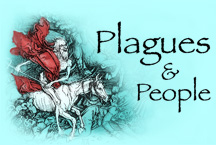
Infectious and Epidemic Disease in History
Department of History
University of California, Irvine
Instructor: Dr. Barbara J. Becker

Department of History
University of California, Irvine
Instructor: Dr. Barbara J. Becker
Supplementary readings for Week 6's lectures include excerpts
from:
Medical theory based on balancing bodily humors did a reasonably good job of helping practitioners diagnose and treat the symptoms of many common illnesses. But it provided little guidance for solving the puzzle of infectious disease. That didn't stop the flow of questions!
Samuel Pepys (pronounced PEEPS) enjoyed a long and distinguished career as an administrator in the British Navy. For ten years, beginning on January 1, 1660, Pepys kept a personal diary. Thanks to his diligence and wit--and his remarkable ability to be in the thick of whatever it was that was happening--we are able to experience everyday life in Restoration London, and witness the historic events of that period ourselves, as though firsthand. Of interest to us are his entries relating to the Great Plague which struck London in 1665 and 1666. Like the hero in Daniel Defoe's fictional account of the plague year, Pepys remained in London throughout that terrible time. Although Pepys kept his diary in "real time," Defoe's fictional account didn't appear until 1722, nearly sixty years after the fact. But Defoe didn't have the benefit of Pepys' diary to furnish him with all the details that bring his novel to life. Pepys had left his diary to his alma mater -- Magdalene College, Cambridge. Written in shorthand and sprinkled throughout with words and phrases in several different foreign languages, the diary remained hidden from public view until it was 'discovered' in 1818. A small selection was published in 1825. More complete editions (minus many of Pepys' more personal, and often quite risque, entries) were published in 1848 and 1875. The complete diary (some 10 volumes, in English) was published for the first time by the University of California Press in 1970.
|
 |
| Go to: |
|